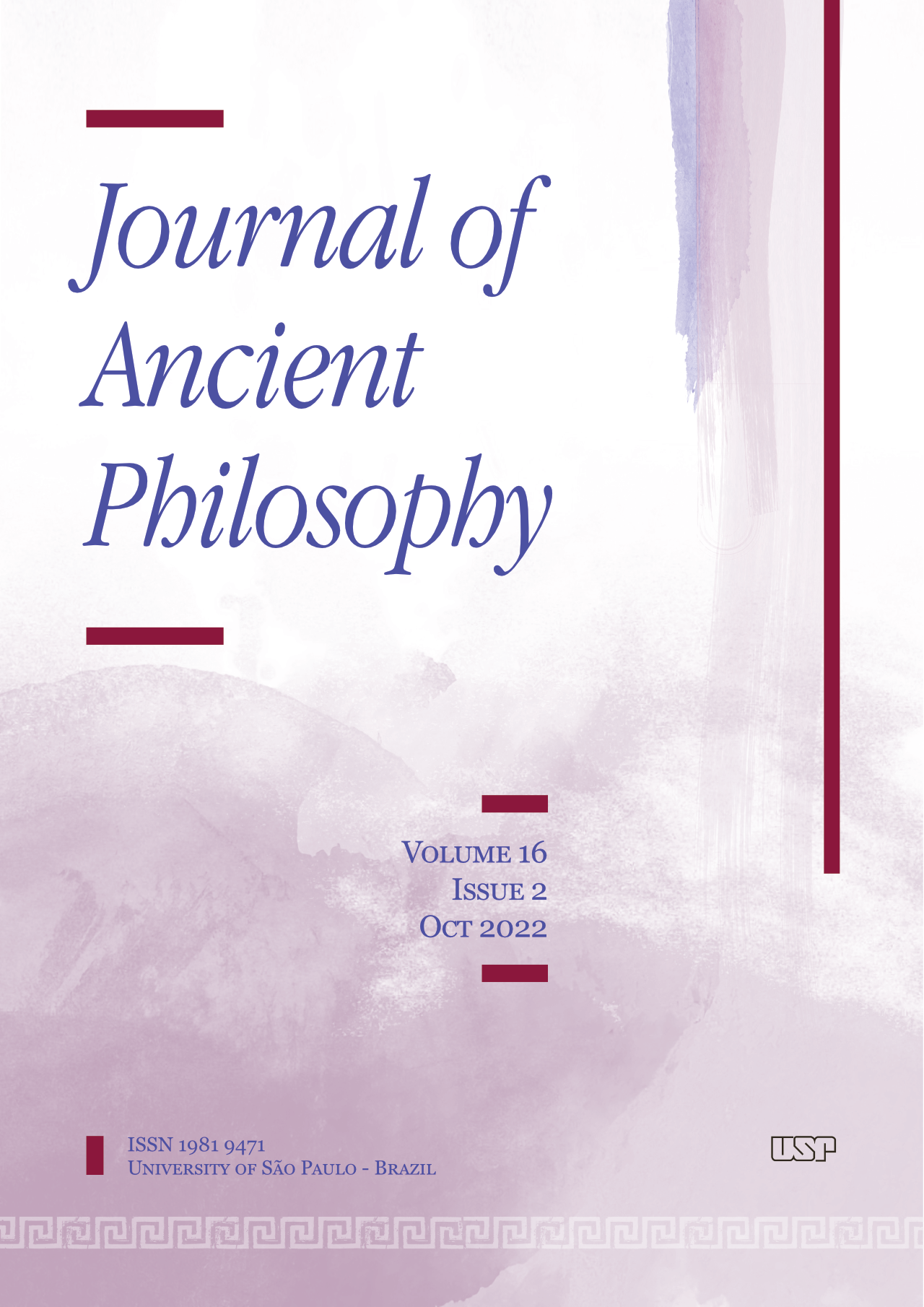Aitiai as Middle Terms
DOI:
https://doi.org/10.11606/issn.1981-9471.v16i2p126-148Palavras-chave:
Aristotle, causes, Avicenna, Posterior analyticsResumo
Aristotle’s aitiai (‘causes’) are middle terms in Aristotelian syllogisms. I argue that stating the aitia of a thing therefore amounts to re-describing this same thing in an alternative and illuminating way. This, in turn, means that a thing and its aitiai really are one and the same thing under different descriptions. The purpose of this paper is to show that this view is implied by Aristotle’s account of explanation, and that it makes more sense than one might expect.
Downloads
Referências
Angioni, Lucas. “Causality and Coextensiveness in Aristotle’s Posterior Analytics 1.13.” Oxford Studies in Ancient Philosophy 54, 2018, 159–185.
Avicenna. Al-Shifā’, Ilāhiyāt, ed. Anawati et al. (Cairo: Al-Hay’ah al-‘Āmma li-Shu’ūn al-Muṭābi‘ al-’Amīrīya 1960).
Avicenna. Al-Shifā’, Ṭabī‘iyāt, ed. Zāyid (Cairo: AI-Hay’ah al-Miṣrīyah al-‘Amma lil-Kitāb 1983).
Avicenna. The Metaphysics of The Healing, tr. Marmura (Utah: Brigham Young University Press 2005).
Avicenna. The Physics of The Healing, tr. McGinnis (Utah: Brigham Young University Press 2009).
Barnes, Jonathan. Aristotle: Posterior Analytics (Oxford: Clarendon Press 1993).
Charles, David. Aristotle on Meaning and Essence (Oxford: Clarendon Press 2000).
Delcomminette, Sylvain. “Qu’est-ce qu’un principe selon Aristote?” In: M.-A. Gavray and A. Michalewski, eds., Les principes cosmologiques du platonisme (Turnhout: Brepols 2017).
Geach, Peter T. Logic Matters (Oxford: Basil Blackwell 1972).
Hasse, Dag Nikolaus. Avicenna’s De anima in the Latin West (London: The Warburg Institute 2000).
Hennig, Boris. Aristotle’s Four Causes (New York: Peter Lang 2019).
Janssens, Jules. “The Notions of wāhib al-ṣuwar (Giver of Forms) and wāhib al-‘aql (Bestower of Intelligence) in Ibn Sīnā”. In: M.C. Pachecho and J.F. Meirinhos, eds., Intellect et imagination dans la Philosophie Médiévale (Turnhout: Brepols 2006).
Johnson, Monte Ransome. Aristotle on Teleology (Oxford: Clarendon Press 2005).
Kupreeva, Inna. “Aristotle on Causation and Conditional Necessity: Analytica Posteriora II 12 in Context.” In: F. De Haas, M. Leunissen, and M. Martijn, eds., Interpreting Aristotle’s Posterior Analytics in Late Antiquity and Beyond (Leiden: Brill 2010).
Lenci, Alessandro. “The Structure of Predication.” Synthese 114(2), 1998, 233–276.
Leunissen, Mariska. “The Structure of Teleological Explanations in Aristotle: Theory and Practice.” Oxford Studies in Philosophy XXXIII, 2007, 145–178.
Lloyd, G.E.R. Methods and Problems in Greek Science (Cambridge: Cambridge University Press 1991).
Marmodoro, Anna. “The Union of Cause and Effect in Aristotle’s Physics 3.3.” Oxford Studies in Ancient Philosophy XXXII, 2007, 205–232.
McGinnis, Jon. Avicenna (Oxford: Oxford University Press 2010).
Moravcsik, Julius M. E. “Aristotle on Adequate Explanation.” Synthese 28(1), 1974, 3–17.
Robin, Léon. “Sur la conception aristotélicienne de la causalité.” Archiv für Geschichte der Philosophie 23(1–2), 1910, 1–28 and 184–210.
Rosen, Jacob. “Essence and End in Aristotle.” Oxford Studies in Ancient Philosophy 46, 2014, 73–107.
Ross, W. D. Aristotle’s Prior and Posterior Analytics (Oxford: Clarendon Press 1957).
Sandstad, Petter. “The Formal Cause in the Posterior Analytics.” Filozofski vestnik 37(1), 2016, 7–26.
Stein, Nathaniel. “Aristotle’s Causal Pluralism.” Archiv für Geschichte der Philosophie 93, 2011, 121–147.
Thomson, Judith Jarvis. “The Statue and the Clay.” Noûs 32(2), 1998, 149–173.
Wagner, Hans. Aristoteles, Physikvorlesung (Darmstadt: Wissenschaftliche Buchgesellschaft 1967).
Wieland, Wolfgang. “Zeitliche Kausalstrukturen in der aristotelischen Logik.” Archiv für Geschichte der Philosophie 54(3), 1972, 229–237.
Downloads
Publicado
Edição
Seção
Licença

Este trabalho está licenciado sob uma licença Creative Commons Attribution-NonCommercial 4.0 International License.
Autores que publicam nesta revista concordam com os seguintes termos:- Autores mantém os direitos autorais e concedem à revista o direito de primeira publicação, com o trabalho simultaneamente licenciado sob a Licença Creative Commons Attribution (CC 4.0) que permite o compartilhamento do trabalho com reconhecimento da autoria e publicação inicial nesta revista.
- Autores têm autorização para assumir contratos adicionais separadamente, para distribuição não-exclusiva da versão do trabalho publicada nesta revista (ex.: publicar em repositório institucional ou como capítulo de livro), com reconhecimento de autoria e publicação inicial nesta revista.
- Autores têm permissão e são estimulados a publicar e distribuir seu trabalho online (ex.: em repositórios institucionais ou na sua página pessoal) a qualquer ponto antes ou durante o processo editorial, já que isso pode gerar alterações produtivas, bem como aumentar o impacto e a citação do trabalho publicado (Veja O Efeito do Acesso Livre).


